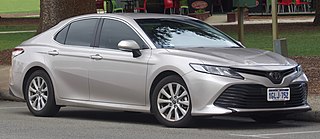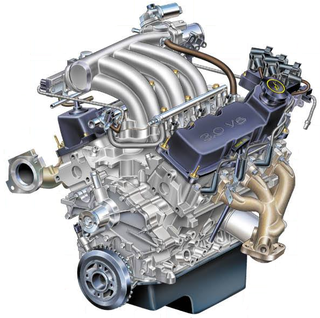
The Ford GT40 is a high-performance endurance racing car designed and built by the Ford Motor Company. It grew out of the "Ford GT" project, an effort to compete in European long-distance sports car races, against Ferrari, who had won the prestigious 24 Hours of Le Mans race from 1960 to 1965. Ford succeeded with the GT40, winning the 1966 through 1969 races.

A V6 engine is a six-cylinder piston engine where the cylinders share a common crankshaft and are arranged in a V configuration.

The Ford Mustang is a series of American automobiles manufactured by Ford. In continuous production since 1964, the Mustang is currently the longest-produced Ford car nameplate. Currently in its seventh generation, it is the fifth-best selling Ford car nameplate. The namesake of the "pony car" automobile segment, the Mustang was developed as a highly styled line of sporty coupes and convertibles derived from existing model lines, initially distinguished by "long hood, short deck" proportions.

The Ford Taunus is a family car that was sold by Ford Germany throughout Europe. Models from 1970 onward were built on the same basic construction as the Ford Cortina MkIII in the United Kingdom, and later on, the two car models were essentially the same, differing almost only in the placement of the steering wheel. The model line was named after the Taunus mountain range in Germany, and was first made in 1939, and continued through several versions until 1994.

The inline-six engine is a piston engine with six cylinders arranged in a straight line along the crankshaft. A straight-six engine has perfect primary and secondary engine balance, resulting in fewer vibrations than other designs of six or fewer cylinders.

The Reliant Scimitar name was used for a series of sports car models produced by British car manufacturer Reliant between 1964 and 1986. During its 22-year production it evolved from a coupe (GT) into a sports estate (GTE), with a convertible variant (GTC) launched in 1980. All have a fibreglass body mounted on a steel box-section chassis, and Ford engines.

The Ford Transit is a family of light commercial vehicles manufactured by the Ford Motor Company since 1965, primarily as a cargo van, but also available in other configurations including a large passenger van, cutaway van chassis, and a pickup truck. The vehicle is also known as the Ford T-Series, a nomenclature shared with Ford's other light commercial vehicles, the Ford F-Series trucks, and the Ford E-Series chassis. As of 2015, 8 million Transit vans have been sold, making it the third best-selling van of all time and has been produced across four basic platform generations, with various "facelift" versions of each.

The Chevrolet El Camino is a coupé utility vehicle that was produced by Chevrolet between 1959–60 and 1964–1987. Unlike a standard pickup truck, the El Camino was adapted from the standard two-door Chevrolet station wagon platform and integrated the cab and cargo bed into the body.

The Mazda Capella, also known as the 626 in Europe, North America and Southeast Asia, is a mid-size car that was manufactured by Mazda from 1970 until 2002. Sold in the Japanese domestic market under the Capella name, the vehicle was also commonly known in other major markets as the Mazda 626. Ford, Mazda's partner at the time, also used the Capella platform to create the Ford Telstar and Ford Probe. 4,345,279 of the 626 and Telstar models were sold worldwide.

The Toyota Camry is an automobile sold internationally by the Japanese auto manufacturer Toyota since 1982, spanning multiple generations. Originally compact in size (narrow-body), the Camry has grown since the 1990s to fit the mid-size classification (wide-body)—although the two widths co-existed in that decade. Since the release of the wide-bodied versions, Camry has been extolled by Toyota as the firm's second "world car" after the Corolla. As of 2022, the Camry is positioned above the Corolla and below the Avalon or Crown in several markets.
The F platform, or F-body, was General Motors' rear-wheel drive pony car automobile platform from 1967 until 2002. It was based partially on the GM X platform, which was used for compact applications instead of the sporting intent of the F-Body. The only two vehicles to have been built using the F-Body platform are the Chevrolet Camaro and the Pontiac Firebird. The fourth character in the Vehicle Identification Number for an F-body car is "F" on model year 1985 and up vehicles. Earlier Camaros and Firebirds had differing VIN codes, but are now commonly referred to as F-bodies.

The Ford Taunus V4 engine is a 60° V4 piston engine with one balance shaft, introduced by Ford Motor Company in Germany in 1962. The German V4 was built in the Cologne plant and powered the Ford Taunus and German versions of the Consul, Capri, and Transit.

The Ford Vulcan is a 3.0 L V6 engine designed and built by the Ford Motor Company. It debuted in 1986 in the newly launched Ford Taurus. Ford went on to install the Vulcan V6 in a variety of car, van, and pickup truck models until the 2008 model year, after which production stopped.

The Mirage Lightweight Racing Car was a family of race cars built by J.W. Automotive Engineereing (JWAE) at Slough in England, initially to compete in international sports car races in the colours of the Gulf Oil Corporation.

The Rayton-Fissore Magnum is an Italian-designed and built luxury off-roader, in small scale production between 1985 and 1998. The American V8-powered versions were marketed as Laforza and were built from 1989 until 2003.

The European Ford Granada is an executive car manufactured by Ford Europe from 1972 until 1994.

OSI, acronym for Officine Stampaggi Industriali was a coachbuilding company founded in 1960 in Turin by former Ghia president Luigi Segre (1919–63) and Arrigo Olivetti (1889–1977) from the Fergat company, a manufacturer of automotive components. OSI was intended to be an independent design branch of Ghia's, focussing on niche efforts.

The Ford P7 is a range of large family saloons/sedans produced by Ford Germany between autumn 1967 and December 1971. The P7 was marketed as the Ford 17M, Ford 20M and Ford 26M.

The fourteenth generation Ford F-Series is a range of pickup trucks produced by Ford, introduced for the 2021 model year. This was the first generation to include a fully-electric and hybrid pickup truck among the offerings, with the F-150 Lightning EV having entered production in 2022. The F-150 positioned above the midsize Ranger but below the larger Super Duty in the Ford truck lineup.



















